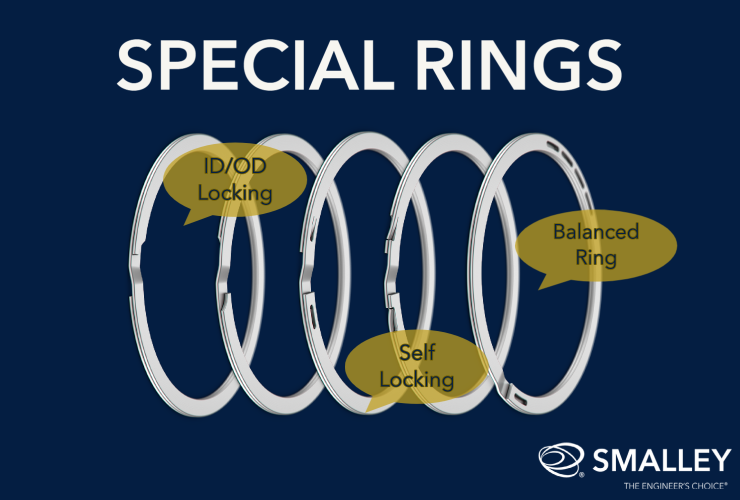
By Justyna Rapacz, Marketing Engineer
Smalley Spirolox Retaining Rings are the trusted industry solution because of their unique configuration, reliability, and convenience across thousands of applications.
While we have five standard types of retaining rings broken down into 30 configurations, we also know that every application is unique.
If one of our standard retaining rings does not fit your application requirements, we offer custom design features to address several assembly considerations, including rotational-dependent applications, balance-critical applications, and interlocking applications.
This blog covers custom design features such as our Self-Locking Ring, Balanced Ring, and ID/OD Locking Ring.
Rotational-Dependent Applications
All retaining rings operating on a rotating shaft are limited by centrifugal forces. If the centrifugal forces are great enough to expand and lift the retaining ring from the groove, failure occurs. As more applications require higher rotational capacities, Smalley is continually investing in ongoing research and development to meet high rotational capacity requirements.
If your application requirements exceed the recommended rotational capacity of a standard retaining ring, a custom ring, or possibly a self-locking ring, may be an option.
Because rotational capacity is a function of several parameters, including thickness, radial wall, cling (interference fit of the ring in the groove), diameter, etc., the rotational capacity may be increased by increasing the radial wall dimension and/or the amount of cling in the groove.
If after investigating this, the rotational capacity is still not sufficient, then we can add a self-locking feature to the ring.
What is a self-locking ring and how does it work?
A self-locking ring is a custom retaining ring feature that increases the ring’s rotational capacity, ideal for applications that have high rotational requirements.
The self-locking feature consists of a tab and a slot that interlock to prevent the ring from expanding. The tab lines up with a slot on the mating turn such that when the ring is installed into the groove, the tab seats inside the slot.
This feature allows the ring to function properly at speeds far exceeding the rotational capacity of a standard retaining ring. The self-locking feature makes it possible for the ring to operate at high speeds, withstand vibration, function under rapid acceleration, and absorb a degree of impact loading.
The self-locking tabs can be designed on the outside diameter (for external retaining rings), on the inside diameter (for internal retaining rings), or on the centerline of the ring.

Installation of the self-locking ring follows the same process as installing a standard Spirolox retaining ring. Both tabs must be fully secured in their respective slots on the mating turn. Proper installation can be visually inspected.
Balance-Critical Applications
When the balance of your assembly is critical, such as a rotor, Smalley offers a balanced ring design.
What is a balanced ring and how does it work?
A balanced ring is a custom feature that may be added to reduce the residual imbalance of the ring itself. By reducing the residual imbalance of the ring, this helps reduce the overall imbalance of the entire assembly.
Smalley’s balance feature statically balances the retaining ring. A series of slots, opposite of the gap end, are placed such that the ring’s center of gravity is statically balanced along its axis of rotation.

Tamper-Proof Applications
If you require a locking mechanism in your assembly, Smalley offers an ID/OD Locking Ring.
What is an ID/OD Locking Ring and how does it work?
An ID/OD Locking Ring is a retaining ring that operates in an internal and external groove simultaneously, creating a concealed, tamper-proof assembly.
The ID/OD lock is beneficial for applications that require two mating components to be held together in an assembly, but also rotate freely.
There is a groove in both components that traps the ring, locking the ring on both the inner diameter (ID) and outer diameter (OD); hence, the term ID/OD lock. The ring cannot be removed, and the two components cannot be disassembled without damaging the ring and assembly.

Typically, the groove diameter in the housing is oversized to accommodate the ring diameter as it expands over the shaft. The ring is first installed loosely into the housing groove, and then the housing is pushed onto the mating component (shaft). The ring ID expands to the shaft diameter, then snaps into the shaft groove. The ring will then cling tightly to the shaft groove.
The oversized groove in the housing allows the two components to rotate relative to each other, while the ring keeps both components locked together. The ring is hidden from view, keeping two pieces connected in an easy and inexpensive manner that is aesthetically pleasing.
Key Points
- Smalley offers special retaining ring design features for many different assembly considerations, including applications that have high rotational capacities, balance requirements, and interlocking requirements.
- Contact a Smalley Engineer to discuss a special ring design for your application.
Interested in learning more?
We’ve put together a FAQ Retaining Ring E-Book for you.
Sponsored content by Smalley
Filed Under: SPONSORED CONTENT






